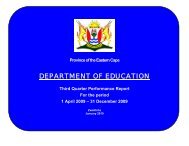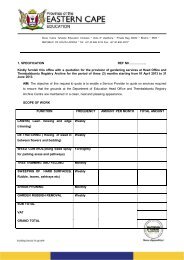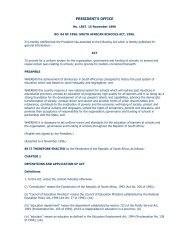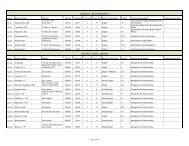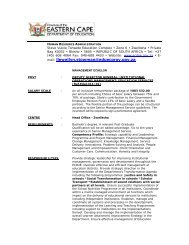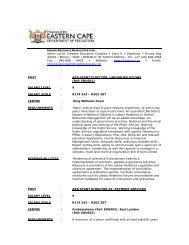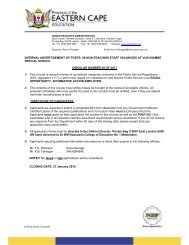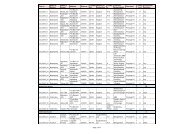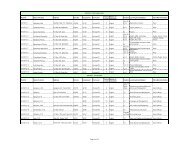School Community Integration Pilot Project - Department of Education
School Community Integration Pilot Project - Department of Education
School Community Integration Pilot Project - Department of Education
Create successful ePaper yourself
Turn your PDF publications into a flip-book with our unique Google optimized e-Paper software.
A comparative analysis <strong>of</strong> education expenditure in Eastern Cape schools – November 2004<br />
• The term ‘Lower’ Secondary <strong>School</strong>s has the potential to cause confusion.<br />
The type <strong>of</strong> school indicated here exists mostly in the former Ciskei areas <strong>of</strong><br />
the province and covers grades 8 to 10. In the ex-Ciskei these schools are<br />
called junior secondary schools. They must not however be confused with<br />
combined or junior secondary schools in the ex-Transkei, which cover grades<br />
R to 9 and are much greater in number. Hence the term ‘lower’ secondary<br />
school is used throughout this report. They are small schools with a LSR <strong>of</strong><br />
only 135. There are only 55 and many <strong>of</strong> these schools may well be phasing<br />
out or converting progressively to full secondary schools. Typically for small<br />
schools they have low LCRs and LERs.<br />
• Senior Secondary <strong>School</strong>s exist overwhelmingly in the former Transkei.<br />
They are a significant part <strong>of</strong> the secondary system with 417 in total, more<br />
than the number <strong>of</strong> secondary schools. They are smaller than average for<br />
secondary schools. They have a low LER but a relatively high LCR, indicating<br />
classroom backlogs.<br />
• There is one Museum <strong>School</strong> in Port Elizabeth.<br />
3.2.3. Public schools by education district<br />
The table below sets out the main indicators by education district. A series <strong>of</strong><br />
conclusions on the geographical differences across the province can be drawn by<br />
grouping the districts that have similar characteristics:<br />
• Graaf Reinet, Cradock, Grahamstown, and Uitenhage mostly cover farming<br />
areas from the former Cape Province. Fort Beaufort, Queenstown and<br />
Sterkspruit are also mostly rural but also include former homeland areas. The<br />
defining characteristic <strong>of</strong> these districts is the prevalence <strong>of</strong> small rural<br />
schools. LERs and LCRs are low and similar, generally below 30 in both<br />
cases, although with LCRs higher in the districts with former homeland areas.<br />
• Port Elizabeth and East London are mostly urban districts. LERs and LCRs<br />
are relatively favourable and similar in the range <strong>of</strong> 32 to 34, indicating a<br />
good and matching level <strong>of</strong> both classroom and educator provisioning.<br />
• Butterworth, C<strong>of</strong>imvaba, Lady Frere, Engcobo, Idutywa, Mount Fletcher,<br />
Qumbu, Maluti, Mount Frere and Umzimkulu cover the south-eastern and<br />
northern areas <strong>of</strong> the former Transkei. The defining characteristic <strong>of</strong> these<br />
districts is a high LCR due to classroom backlogs, but a relatively favourable<br />
LER. LCRs range from 33.2 to 44.3 but are generally close to the provincial<br />
average. LERs range from 28.6 to 34.5 but are mostly below the provincial<br />
average. <strong>School</strong>s in these districts generally have good educator provisioning<br />
but despite progress still face significant classroom backlogs.<br />
• Umtata, Libode, Lusikisiki and Bizana are the districts with some <strong>of</strong> the<br />
deepest rural poverty in South Africa. <strong>School</strong>s in these districts face major<br />
resource challenges. LCRs range from 50 to 56.5 with LERs ranging from<br />
34.5 to 38.6. <strong>School</strong>s in these districts have to contend with serious<br />
classroom backlogs. Educator provisioning is worse than for the rest <strong>of</strong> the<br />
province but is still at levels that can provide teaching in manageable class<br />
sizes.<br />
One <strong>of</strong> the most significant features <strong>of</strong> the former Transkei education districts is the<br />
wide variation between LCR and LER. While the LER is below 35:1 in 11 out <strong>of</strong><br />
21



